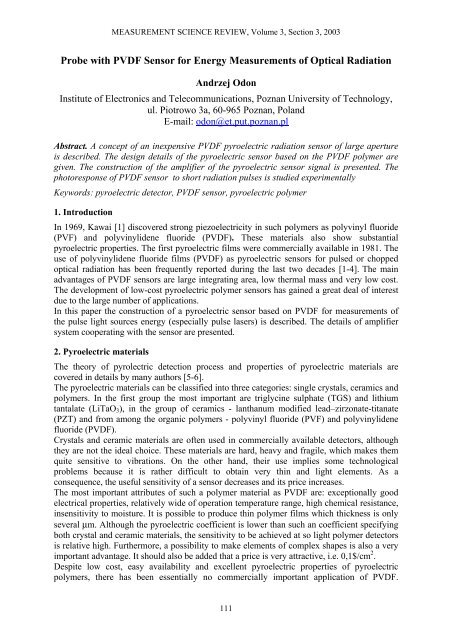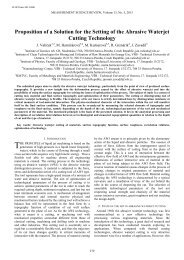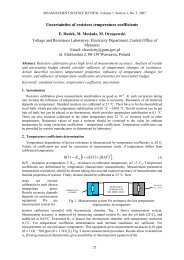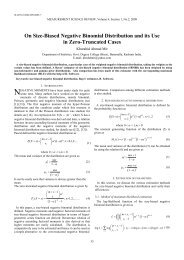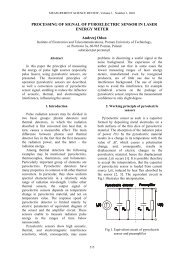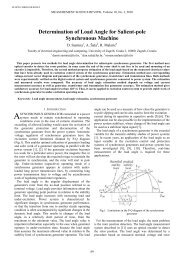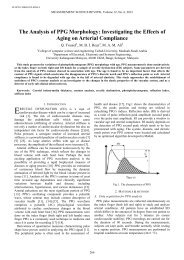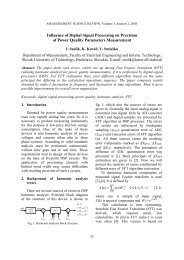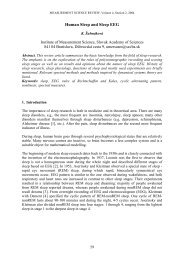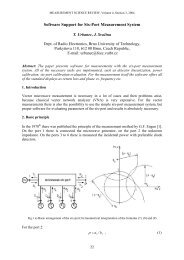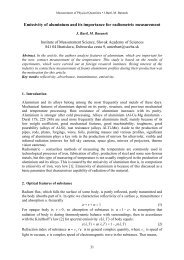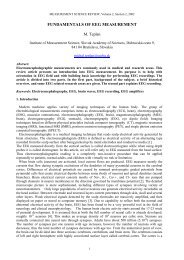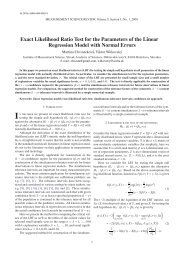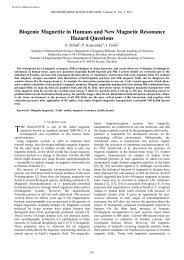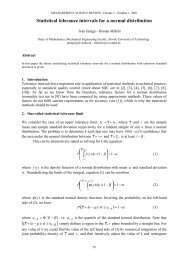Probe with PVDF Sensor for Energy Measurements of Optical ...
Probe with PVDF Sensor for Energy Measurements of Optical ...
Probe with PVDF Sensor for Energy Measurements of Optical ...
Create successful ePaper yourself
Turn your PDF publications into a flip-book with our unique Google optimized e-Paper software.
MEASUREMENT SCIENCE REVIEW, Volume 3, Section 3, 2003<br />
<strong>Probe</strong> <strong>with</strong> <strong>PVDF</strong> <strong>Sensor</strong> <strong>for</strong> <strong>Energy</strong> <strong>Measurements</strong> <strong>of</strong> <strong>Optical</strong> Radiation<br />
Andrzej Odon<br />
Institute <strong>of</strong> Electronics and Telecommunications, Poznan University <strong>of</strong> Technology,<br />
ul. Piotrowo 3a, 60-965 Poznan, Poland<br />
E-mail: odon@et.put.poznan.pl<br />
Abstract. A concept <strong>of</strong> an inexpensive <strong>PVDF</strong> pyroelectric radiation sensor <strong>of</strong> large aperture<br />
is described. The design details <strong>of</strong> the pyroelectric sensor based on the <strong>PVDF</strong> polymer are<br />
given. The construction <strong>of</strong> the amplifier <strong>of</strong> the pyroelectric sensor signal is presented. The<br />
photoresponse <strong>of</strong> <strong>PVDF</strong> sensor to short radiation pulses is studied experimentally<br />
Keywords: pyroelectric detector, <strong>PVDF</strong> sensor, pyroelectric polymer<br />
1. Introduction<br />
In 1969, Kawai [1] discovered strong piezoelectricity in such polymers as polyvinyl fluoride<br />
(PVF) and polyvinylidene fluoride (<strong>PVDF</strong>). These materials also show substantial<br />
pyroelectric properties. The first pyroelectric films were commercially available in 1981. The<br />
use <strong>of</strong> polyvinylidene fluoride films (<strong>PVDF</strong>) as pyroelectric sensors <strong>for</strong> pulsed or chopped<br />
optical radiation has been frequently reported during the last two decades [1-4]. The main<br />
advantages <strong>of</strong> <strong>PVDF</strong> sensors are large integrating area, low thermal mass and very low cost.<br />
The development <strong>of</strong> low-cost pyroelectric polymer sensors has gained a great deal <strong>of</strong> interest<br />
due to the large number <strong>of</strong> applications.<br />
In this paper the construction <strong>of</strong> a pyroelectric sensor based on <strong>PVDF</strong> <strong>for</strong> measurements <strong>of</strong><br />
the pulse light sources energy (especially pulse lasers) is described. The details <strong>of</strong> amplifier<br />
system cooperating <strong>with</strong> the sensor are presented.<br />
2. Pyroelectric materials<br />
The theory <strong>of</strong> pyrolectric detection process and properties <strong>of</strong> pyroelectric materials are<br />
covered in details by many authors [5-6].<br />
The pyroelectric materials can be classified into three categories: single crystals, ceramics and<br />
polymers. In the first group the most important are triglycine sulphate (TGS) and lithium<br />
tantalate (LiTaO 3 ), in the group <strong>of</strong> ceramics - lanthanum modified lead–zirzonate-titanate<br />
(PZT) and from among the organic polymers - polyvinyl fluoride (PVF) and polyvinylidene<br />
fluoride (<strong>PVDF</strong>).<br />
Crystals and ceramic materials are <strong>of</strong>ten used in commercially available detectors, although<br />
they are not the ideal choice. These materials are hard, heavy and fragile, which makes them<br />
quite sensitive to vibrations. On the other hand, their use implies some technological<br />
problems because it is rather difficult to obtain very thin and light elements. As a<br />
consequence, the useful sensitivity <strong>of</strong> a sensor decreases and its price increases.<br />
The most important attributes <strong>of</strong> such a polymer material as <strong>PVDF</strong> are: exceptionally good<br />
electrical properties, relatively wide <strong>of</strong> operation temperature range, high chemical resistance,<br />
insensitivity to moisture. It is possible to produce thin polymer films which thickness is only<br />
several µm. Although the pyroelectric coefficient is lower than such an coefficient specifying<br />
both crystal and ceramic materials, the sensitivity to be achieved at so light polymer detectors<br />
is relative high. Furthermore, a possibility to make elements <strong>of</strong> complex shapes is also a very<br />
important advantage. It should also be added that a price is very attractive, i.e. 0,1$/cm 2 .<br />
Despite low cost, easy availability and excellent pyroelectric properties <strong>of</strong> pyroelectric<br />
polymers, there has been essentially no commercially important application <strong>of</strong> <strong>PVDF</strong>.<br />
111
Measurement <strong>of</strong> Physical Quantities<br />
● A. Odon<br />
Although such famous manufactures as e.g. Molectron and Coherent that currently produce<br />
devices <strong>for</strong> measurements <strong>of</strong> laser energy and power, do not use polymer materials in<br />
measuring probes a lot <strong>of</strong> articles still concern <strong>with</strong> investigations and applications <strong>of</strong> <strong>PVDF</strong>.<br />
3. The sensor construction<br />
A pyroelectric sensor based on <strong>PVDF</strong> has been designed and constructed. Figure 1 illustrates<br />
the sensor construction, while its main features are specified in Table 1.<br />
Table 1. Main features <strong>of</strong> the constructed <strong>PVDF</strong> sensor<br />
Parameter<br />
Aperture: diameter<br />
13 mm<br />
Aperture: area 1,69 cm 2<br />
Material<br />
Aluminium metallized piezo/pyroelectric film <strong>PVDF</strong><br />
Thickness <strong>of</strong> <strong>PVDF</strong> film 25 µm<br />
<strong>Sensor</strong> configuration<br />
Flat<br />
Capacitance<br />
590 pF<br />
Voltage responsivity<br />
70 mV/mJ<br />
The sensing element is a piece <strong>of</strong> <strong>PVDF</strong> foil <strong>of</strong> 25 µm in thickness and 13 mm in diameter.<br />
Both sides <strong>of</strong> the foil are covered <strong>with</strong> aluminium. The front sensor surface which is exposed<br />
to radiation, is electrically connected to the head in order to avoid <strong>of</strong> electromagnetic<br />
disturbances. The back sensor surface is connected to the signal electrode <strong>of</strong> the sensor.<br />
Insulating ring<br />
Aluminium electrodes<br />
<strong>PVDF</strong><br />
Signal electrode<br />
Fig. 1. Schematic <strong>of</strong> the sensor <strong>with</strong> <strong>PVDF</strong> foil<br />
Figure 2 presents the view <strong>of</strong> the constructed sensor.<br />
Fig. 2. View <strong>of</strong> the constructed <strong>PVDF</strong> sensor<br />
112
MEASUREMENT SCIENCE REVIEW, Volume 3, Section 3, 2003<br />
The exemplary record <strong>of</strong> an output signal acquired from the realized <strong>PVDF</strong> sensor allows a<br />
determination <strong>of</strong> the response time <strong>of</strong> this sensor. In particular, it is possible to determine<br />
three components <strong>of</strong> the total response time: rise time, decay time and recovery time. Fig. 3<br />
and Fig 4 .show the voltage detector response to a short (20 µs) radiation pulse.<br />
U max = c E<br />
Fig.3. Rise <strong>of</strong> voltage response signal (c1)<strong>of</strong> the<br />
constructed <strong>PVDF</strong> sensor excited <strong>with</strong> a short (20 µs)<br />
radiation pulse (c2)<br />
Fig.4. Voltage response <strong>of</strong> the constructed <strong>PVDF</strong><br />
sensor to a short radiation pulse<br />
(width <strong>of</strong> pulse is 20 µs)<br />
Results <strong>of</strong> the experiments show that the recovery time is equal about 34 ms, while the decay<br />
time is 6 ms, and the response time is about 120 µs.<br />
4. Scheme <strong>of</strong> the amplifier <strong>of</strong> the <strong>PVDF</strong> sensor signal<br />
The amplification <strong>of</strong> the output signal <strong>of</strong> the detector can be realised either in the voltage<br />
mode <strong>with</strong> a high impedance amplifier or in the current mode <strong>with</strong> a transresistance amplifier<br />
(current-voltage converter). The operation in the voltage mode permits getting a relatively<br />
high output voltage signal, while the current mode ensures a possibility <strong>of</strong> measuring the<br />
energy <strong>of</strong> radiation pulses <strong>of</strong> high frequency <strong>of</strong> repetition. Designed and constructed amplifier<br />
system operate in the voltage mode. A scheme <strong>of</strong> the amplifier system is shown in Fig. 5.<br />
R3 20k<br />
Lf356<br />
R2 10k<br />
C1<br />
U2<br />
R1<br />
10 M<br />
U1<br />
CA 3140<br />
220 nF<br />
R4<br />
100k<br />
U3<br />
4052<br />
Y<br />
Y0<br />
Y1<br />
Y2<br />
A<br />
B<br />
R5<br />
9.9k<br />
100<br />
R6<br />
R7<br />
9k<br />
R8<br />
1k<br />
Fig. 5 A scheme <strong>of</strong> the amplifier <strong>of</strong> the <strong>PVDF</strong> sensor output signal.<br />
113
Measurement <strong>of</strong> Physical Quantities<br />
● A. Odon<br />
The system comprises a preamplifier providing a possibility <strong>of</strong> a variable amplification, based<br />
on the operation amplifier U1 (CA 3140), and an amplifier U2 (LF356) allowing adjustment<br />
amplification in the ranges: x1, x10, x100. The resistors in the feedback loop <strong>of</strong> the amplifier<br />
U2 are switched by an analogous key U3 controlled by digital signals A0, A1. The system is<br />
carefully shielded and mounted in the case <strong>of</strong> the probe. Designed curcuit <strong>of</strong> amplifier<br />
cooperates <strong>with</strong> converting system is reported in articles [7-8].<br />
5. Conclusions<br />
In the paper a brief review <strong>of</strong> currently used pyroelectric materials is presented. The design<br />
and construction <strong>of</strong> a sensor <strong>for</strong> measurements <strong>of</strong> impulse radiation energy have been<br />
described. The main element <strong>of</strong> the sensor is a polymer <strong>PVDF</strong> detector <strong>of</strong> relatively large area<br />
<strong>of</strong> a very low price when compared to that <strong>of</strong> standard sensors <strong>for</strong> radiation energy<br />
measurements. A system <strong>of</strong> an amplifier cooperating <strong>with</strong> the sensor has been designed and<br />
constructed. The study is in progress.<br />
References<br />
1. H Kawai, The piezoelectricity <strong>of</strong> polyvinylidene fluoride, Jap. J. Appl. Phys.,8:<br />
pp. 975-976, 1969<br />
2. B. Ploss and A. Domig, Static and dynamic pyroelectric properties <strong>of</strong> <strong>PVDF</strong>,<br />
Ferroelectrics, 159, pp. 263−268, 1994<br />
3. S.Webster and T.D. Binnie, <strong>PVDF</strong> sensors <strong>with</strong> low temperature bonding techniques,<br />
<strong>Sensor</strong>s and Actuators, A 49, pp. 61−65, 1995<br />
4. F. Armitage, K. Benjamin, D. Setiadi, H. Weller, D.Binnie, Infrared sensing using<br />
pyroelectric polymers sensors and their applications VIII, Section F: <strong>Optical</strong> and Fibre<br />
optics <strong>Sensor</strong>s 7 – 10 September 1997, IOP Publishing LTD, 1997<br />
5. R.W. Whatmore, Pyroelectric devices and materials, Rep.Prog.Phys. 49,1335-1386, 1986<br />
6. J. Fraden, Handbook <strong>of</strong> Modern <strong>Sensor</strong>s, 2nd ed., AIP Press, New York, 1997<br />
7. A.Odon, Processing <strong>of</strong> signal <strong>of</strong> pyroelectric sensor in laser energy meter, Proc. 3 rd Intern.<br />
Conf. on Measurement 2001, Smolenice, Slovak Republic, May 14-17, 2001<br />
pp. 339−342<br />
8. A. Odon, Processing <strong>of</strong> signal <strong>of</strong> pyroelectric sensor in laser energy meter, Measurement<br />
Science Review (http://www.measurement.sk) 1, 2001, vol 1, pp. 215-218<br />
114


